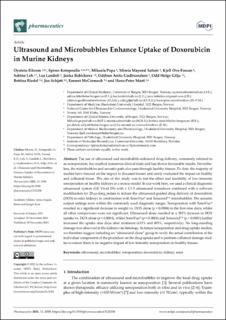| dc.contributor.author | Eikrem, Øystein Solberg | |
| dc.contributor.author | Kotopoulis, Spiros | |
| dc.contributor.author | Popa, Mihaela-Lucia | |
| dc.contributor.author | Safont, Mireia Mayoral | |
| dc.contributor.author | Fossan, Kjell Ove | |
| dc.contributor.author | Leh, Sabine | |
| dc.contributor.author | Landolt, Lea | |
| dc.contributor.author | Babickova, Janka | |
| dc.contributor.author | Gudbrandsen, Oddrun Anita | |
| dc.contributor.author | Gilja, Odd Helge | |
| dc.contributor.author | Riedel, Bettina Maria Ingeborg | |
| dc.contributor.author | Schjøtt, Jan Didrik | |
| dc.contributor.author | McCormack, Emmet | |
| dc.contributor.author | Marti, Hans-Peter | |
| dc.date.accessioned | 2021-12-01T10:17:35Z | |
| dc.date.available | 2021-12-01T10:17:35Z | |
| dc.date.created | 2021-11-29T19:34:26Z | |
| dc.date.issued | 2021-11-29 | |
| dc.identifier.issn | 1999-4923 | |
| dc.identifier.uri | https://hdl.handle.net/11250/2832307 | |
| dc.description.abstract | The use of ultrasound and microbubble-enhanced drug delivery, commonly referred to as sonoporation, has reached numerous clinical trials and has shown favourable results. Nevertheless, the microbubbles and acoustic path also pass through healthy tissues. To date, the majority of studies have focused on the impact to diseased tissues and rarely evaluated the impact on healthy and collateral tissue. The aim of this study was to test the effect and feasibility of low-intensity sonoporation on healthy kidneys in a mouse model. In our work here, we used a clinical diagnostic ultrasound system (GE Vivid E9) with a C1-5 ultrasound transducer combined with a software modification for 20-µs-long pulses to induce the ultrasound-guided drug delivery of doxorubicin (DOX) in mice kidneys in combination with SonoVue® and Sonazoid™ microbubbles. The acoustic output settings were within the commonly used diagnostic ranges. Sonoporation with SonoVue® resulted in a significant decrease in weight vs. DOX alone (p = 0.0004) in the first nine days, whilst all other comparisons were not significant. Ultrasound alone resulted in a 381% increase in DOX uptake vs. DOX alone (p = 0.0004), whilst SonoVue® (p = 0.0001) and Sonazoid™ (p < 0.0001) further increased the uptake nine days after treatment (419% and 493%, respectively). No long-standing damage was observed in the kidneys via histology. In future sonoporation and drug uptake studies, we therefore suggest including an “ultrasound alone” group to verify the actual contribution of the individual components of the procedure on the drug uptake and to perform collateral damage studies to ensure there is no negative impact of low-intensity sonoporation on healthy tissues. | en_US |
| dc.language.iso | eng | en_US |
| dc.publisher | MDPI | en_US |
| dc.rights | Navngivelse 4.0 Internasjonal | * |
| dc.rights.uri | http://creativecommons.org/licenses/by/4.0/deed.no | * |
| dc.title | Ultrasound and Microbubbles Enhance Uptake of Doxorubicin in Murine Kidneys | en_US |
| dc.type | Journal article | en_US |
| dc.type | Peer reviewed | en_US |
| dc.description.version | publishedVersion | en_US |
| dc.rights.holder | Copyright 2021 the authors | en_US |
| dc.source.articlenumber | 2038 | en_US |
| cristin.ispublished | true | |
| cristin.fulltext | original | |
| cristin.qualitycode | 1 | |
| dc.identifier.doi | 10.3390/pharmaceutics13122038 | |
| dc.identifier.cristin | 1961169 | |
| dc.source.journal | Pharmaceutics | en_US |
| dc.identifier.citation | Pharmaceutics. 2021, 13 (12), 2038. | en_US |
| dc.source.volume | 13 | en_US |
| dc.source.issue | 12 | en_US |

